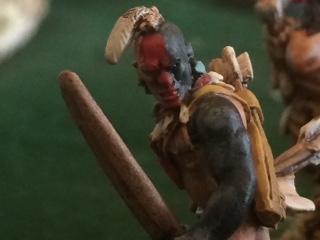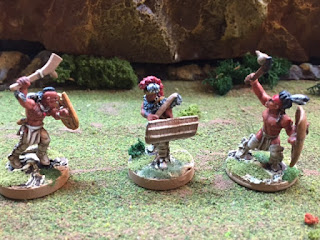Close Combat Playtest
A playtest report sent to us by Howard Whitehouse, the writer of the rules. Enjoy...
 My regular gaming partner and opponent Dan Foley agreed that we'd try out a couple of changes to the rules. Both Roderick and Lee had suggested that, instead of the existing 'I hit you/you hit me' system, we let the defender also hit when he scored more successes than the attacker.
My regular gaming partner and opponent Dan Foley agreed that we'd try out a couple of changes to the rules. Both Roderick and Lee had suggested that, instead of the existing 'I hit you/you hit me' system, we let the defender also hit when he scored more successes than the attacker.This involved a minor change to let the defender redeploy his figures before combat, but this was straightforward enough. Since we wanted to focus on close combat,
both Dan's Mohawks and my Huron's split into a larger group on the valley floor, while putting a smaller group of archers across the creek to provide 'arrow support'. Dan outfoxed me in getting his men into a higher position, and my attempts to rush my archers up the 'natural staircase' to the top of the cliff were accompanied by a collection of light wounds - and a kill - from Dan's laughing bowmen.
Dan's 'close combat force' came forward, and I did the same. He responded by charging into my Huron's as a Reaction, surprising me, and won a round of close combat. My Great Warrior was wounded three times, and a lesser man would have died. However, protected by a gallant (and lucky) war bearer, who fended off Dan's leader, I was able (purely by sheer luck of the dice) to kill his companion in gloriously gory style, and also his stripling. Dan failed his Nerve test and bolted. However, he rolled a total of 5", and my victorious band were easily able to follow up and knock the great warrior to the ground, and bind him as a prisoner. And that won the game.
 We tried the suggestion that there just be one round of melee rather than a 'attacker goes first, then defender becomes attacker', so that a successful - say - Leap Aside hits the opponent rather than simply disengages
We tried the suggestion that there just be one round of melee rather than a 'attacker goes first, then defender becomes attacker', so that a successful - say - Leap Aside hits the opponent rather than simply disengages without being hurt. That worked fine,
although a few more tests will be required to make sure there aren't any unforeseen weird
effects to alter the balance. However, the two-attack method starts with "attacker fights defenders he reaches, plus their immediate supporters" meaning it's possible to attack a spread-out group and deliberately pick on those nearest while keeping the more distant figures out of the fight.
So it would look something like this
 if pictured from above --
if pictured from above --
X
X XX
OOOO
Where the O's jump on two of the X's while ignoring the others. Then, on their response, the other X's pile in. With a 'one resolution' version, the X's use their Reaction to either shoot at the attackers OR move, say one walk distance towards the fight. That way everyone is in position for the close combat. Unless they roll badly. Which seems fair.
So their may have to be some more testing and a rewrite of this rules section to explain the
'one resolution' version.



Comments
Post a Comment